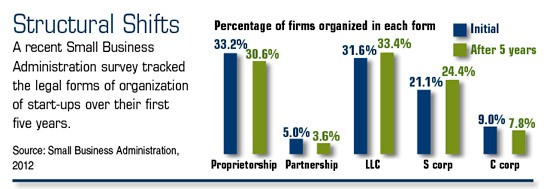|
Showing posts with label Naperville Small Business Planning. Show all posts
Showing posts with label Naperville Small Business Planning. Show all posts
Tuesday, October 2, 2012
The ABC's of Business Structure
Tuesday, July 24, 2012
Hanging the “Help Wanted” Sign
 Toward the end of 2011, an index that measures the hiring intentions of small businesses rose to its highest level in three years, and another report estimated that small businesses have added about 1.2 million new jobs since October 2009.1–2 All told, businesses with fewer than 500 employees have created about 65% of new jobs in the United States over the last 20 years.3
Toward the end of 2011, an index that measures the hiring intentions of small businesses rose to its highest level in three years, and another report estimated that small businesses have added about 1.2 million new jobs since October 2009.1–2 All told, businesses with fewer than 500 employees have created about 65% of new jobs in the United States over the last 20 years.3
Business owners may need to invest a fair amount of time and money to build a good team. Adding a salary can be substantial by itself. However, you must also consider the potential costs and responsibilities beyond wages when you are ready to hire new staff members.
Begin with the Big 4
Benefits. Employers that provide benefits such as health and dental plans, disability coverage, and life insurance may need to factor in costs ranging from 1.25 to 1.4 times the base salary. For example, an employee who earns $35,000 annually may actually cost the employer $44,000 to $49,000. You may also need to increase the budget for perks provided to existing employees — from free coffee to holiday parties and bonuses.4
Recruiting. It’s not always easy to find the right fit for a new position. There are potential expenses associated with recruiting, including advertising, drug screenings, background checks, as well as the cost for someone to review resumes, screen applicants, and conduct interviews.
 Training. Getting new employees up to speed and making sure they become as productive as possible can also be expensive. Employees spend an average of 32 hours a year on training, and new hires often need additional time to learn the ropes. One report estimated that companies spend about $1,200 annually per employee on training.5
Training. Getting new employees up to speed and making sure they become as productive as possible can also be expensive. Employees spend an average of 32 hours a year on training, and new hires often need additional time to learn the ropes. One report estimated that companies spend about $1,200 annually per employee on training.5
Compliance. Employers must often deal with a complicated array of federal and state regulations. Research may be needed to understand the possible cost of implementing requirements that apply specifically to your area and/or industry.
It’s exciting to discover an opportunity to expand the size or scope of your business, and sometimes extra help is needed to make that happen. Fortunately, successful small businesses are likely to continue providing employment opportunities in the years to come.
1) Businessweek, December 13, 2011
2) The Wall Street Journal, November 30, 2011
3) Associated Press, December 14, 2011
4–5) Yahoo! Finance, July 25, 2011
2) The Wall Street Journal, November 30, 2011
3) Associated Press, December 14, 2011
4–5) Yahoo! Finance, July 25, 2011
The information in this article is not intended as tax or legal advice, and it may not be relied on for the purpose of avoiding any federal tax penalties. You are encouraged to seek tax or legal advice from an independent Naperville Small Business planning advisor. The content is derived from sources believed to be accurate. Neither the information presented nor any opinion expressed constitutes a solicitation for the purchase or sale of any security. This material was written and prepared by Emerald. Copyright © 2012 Emerald Connect, Inc.
Related articles
- I Hired a Zombie: The True Cost of a Bad Hire [INFOGRAPHIC] (mashable.com)
- The Number One Reason Employees Stay in a Small Business, According to Employers (smallbiztrends.com)
Friday, June 29, 2012
Small Companies Face Costly Cybersecurity Threats
 Possibly because many large corporations have enhanced their security policies, 40% of all targeted Internet attacks are directed toward more vulnerable companies with fewer than 500 employees. Unfortunately, only 52% of small businesses have a basic cybersecurity plan.1
Possibly because many large corporations have enhanced their security policies, 40% of all targeted Internet attacks are directed toward more vulnerable companies with fewer than 500 employees. Unfortunately, only 52% of small businesses have a basic cybersecurity plan.1
Small businesses often use the Internet to market their products and services, accept electronic payments, and run their operations effectively. Owners who ignore potential cybersecurity issues may be taking a significant risk.
Whether a company relies on one laptop computer or depends heavily on e-commerce, small-business owners can shore up their defenses and help protect their financial interests.
To help owners understand basic precautions, the Federal Communications Commission (FCC) has introduced the Small Biz Cyber Planner (www.fcc.gov/cyberplanner), a free online tool that allows visitors to customize a planning guide based on their online presence.
Here are a few general cybersecurity tips for small businesses from the FCC.
- Install and update antivirus and antispyware software on every computer.
- Maintain firewalls between the internal network and the Internet to keep outsiders from accessing data on a private network, and make sure that home computers used to conduct business also have firewalls.
- If you have a Wi-Fi network, set it up so that the network name is hidden and a secure password is required for access.
- Create backup copies of important business data and information.
- Lock up computers to prevent them from falling into the wrong hands. Notebooks and tablets, in particular, can easily be stolen if left unattended.
- Train employees in security practices and set up a separate account for each user. Limit the authority to install software and provide access only to the data needed for users to perform their jobs.
- Require all passwords to be changed on a regular basis.
Recovering from a breach can be time-consuming and expensive for companies with smaller staffs and limited resources. Moreover, a company may be held responsible if its customers’ personally identifiable information is disclosed.Internet liability insurance may help shield firms conducting business on the Web from risks related to computer hacking, spam, viruses, and other online perils (up to policy limits).
1) Reuters, October 24, 2011
The information in this article is not intended as tax or legal advice, and it may not be relied on for the purpose of avoiding any federal tax penalties. You are encouraged to seek tax or legal advice from an independent Naperville small business planning advisor. The content is derived from sources believed to be accurate. Neither the information presented nor any opinion expressed constitutes a solicitation for the purchase or sale of any security. This material was written and prepared by Emerald. Copyright © 2012 Emerald Connect, Inc.
Thursday, June 7, 2012
Preparing to Turn the Corner
What happens to a multiple-owner business when one of them chooses to retire or must leave suddenly for some other reason? Death, disability, divorce, and bankruptcy are just a few of the distressing kinds of events that can affect one owner and threaten the future of the entire business. In the midst of an unsettling transition, it may be difficult or even impossible for all interested parties to come to terms.
 It’s often easier to decide exactly how a business should proceed long before something life-changing happens, when the potential effects are still hypothetical and reciprocal. A properly drafted buy-sell agreement is a binding contract that establishes how ownership shares should be transferred when specified triggering events occur, and it may provide a mechanism for determining the value of transferred shares.
It’s often easier to decide exactly how a business should proceed long before something life-changing happens, when the potential effects are still hypothetical and reciprocal. A properly drafted buy-sell agreement is a binding contract that establishes how ownership shares should be transferred when specified triggering events occur, and it may provide a mechanism for determining the value of transferred shares.Several Ways to Go
A buy-sell agreement can be structured to fit a business’s unique circumstances and typically may be used by any business entity, including corporations, partnerships, LLCs, and even proprietorships. Basic buy-sell agreements include:
- Cross-purchase agreement: Stipulates that the remaining owners will purchase the interest of the departing owner.
- Redemption agreement: Provides for the business entity to purchase the interest of the departing owner.
- Hybrid agreement: The business itself has the first option to buy, but if it declines because it is more advantageous for the shareholders to buy, then the shareholders are the purchasers.
Execution Is Everything
Pre-arranging for the business or the partners to buy out a departing owner may be a good idea, but it could prove fruitless if the sale is unexpected and the buyers don’t have the money to close a transaction. For that reason, it may be helpful to fund a buy-sell agreement with life insurance and/or disability income insurance. The guaranteed liquidity from the policies may help prevent survivors from being forced to sell assets or borrow money.
The cost and availability of insurance depend on factors such as age, health, and the type and amount of insurance purchased. Before implementing an insurance strategy, it would be prudent to make sure that you are insurable. Any guarantees are contingent on the claims-paying ability of the issuing insurance company.
The information in this article is not intended as tax or legal advice, and it may not be relied on for the purpose of avoiding any federal tax penalties. You are encouraged to seek tax or legal advice from an independent Naperville small business planning advisor. The content is derived from sources believed to be accurate. Neither the information presented nor any opinion expressed constitutes a solicitation for the purchase or sale of any security. This material was written and prepared by Emerald. Copyright © 2012 Emerald Connect, Inc.
Related articles
Subscribe to:
Comments (Atom)

 The ABCs of
The ABCs of 



